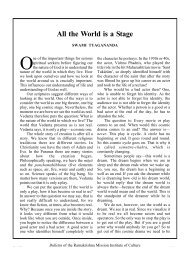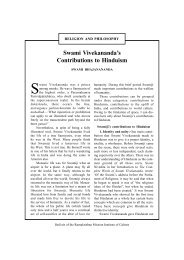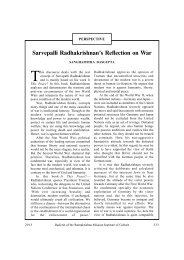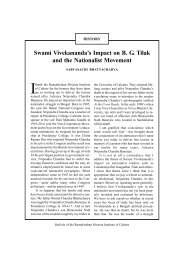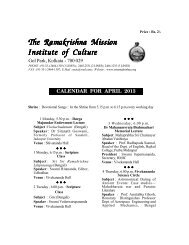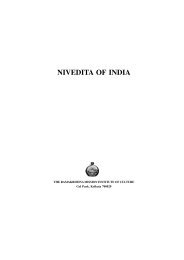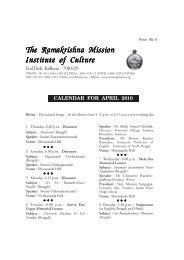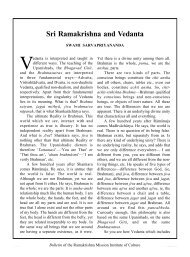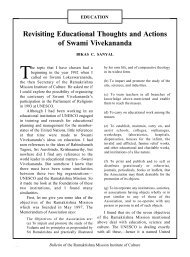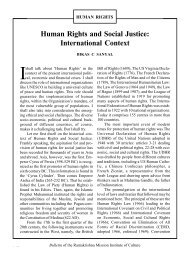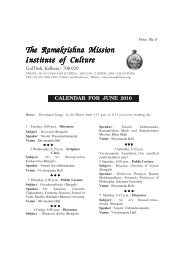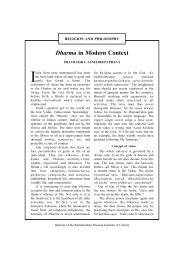Harmony of Religions From the Standpoint of Sri Ramakrishna and ...
Harmony of Religions From the Standpoint of Sri Ramakrishna and ...
Harmony of Religions From the Standpoint of Sri Ramakrishna and ...
You also want an ePaper? Increase the reach of your titles
YUMPU automatically turns print PDFs into web optimized ePapers that Google loves.
HARMONY OF RELIGIONS FROM THE STANDPOINT OF SRI RAMAKRISHNA<br />
RELIGION AND SWAMI AND VIVEKANANDA PHILOSOPHY – I<br />
<strong>Harmony</strong> <strong>of</strong> <strong>Religions</strong> <strong>From</strong> <strong>the</strong> <strong>St<strong>and</strong>point</strong> <strong>of</strong><br />
<strong>Sri</strong> <strong>Ramakrishna</strong> <strong>and</strong> Swami Vivekan<strong>and</strong>a – I<br />
SWAMI BHAJANANANDA<br />
One <strong>of</strong> <strong>the</strong> main problems about<br />
religion is its plurality or diversity.<br />
Not only are <strong>the</strong>re several religions<br />
but <strong>the</strong>y differ from one ano<strong>the</strong>r in many<br />
ways. Fur<strong>the</strong>r, each claims to show <strong>the</strong> right<br />
way <strong>of</strong> life, each claims to provide supreme<br />
peace <strong>and</strong> fulfilment.<br />
The phenomenon <strong>of</strong> plurality <strong>of</strong> religions<br />
raises several philosophical questions. These<br />
questions lead to ano<strong>the</strong>r field known as<br />
‘Comparative Study <strong>of</strong> <strong>Religions</strong>’, <strong>and</strong> so<br />
<strong>the</strong>y are not discussed here.<br />
Diversity <strong>of</strong> religion, however, is not<br />
merely a philosophical problem. It has<br />
immense social, cultural <strong>and</strong> political consequences.<br />
Differences among religions have<br />
been one <strong>of</strong> <strong>the</strong> main causes <strong>of</strong> wars <strong>and</strong><br />
communal riots all through human history.<br />
Even in normal, peaceful society, many<br />
people harbour prejudice <strong>and</strong> ill will towards<br />
followers <strong>of</strong> religions o<strong>the</strong>r than <strong>the</strong>ir own.<br />
More than a hundred years ago, Swami<br />
Vivekan<strong>and</strong>a said: ‘And thus we find that,<br />
though <strong>the</strong>re is nothing that has brought to<br />
man more blessings than religion, yet at <strong>the</strong><br />
same time, <strong>the</strong>re is nothing that has brought<br />
more horror than religion. Nothing has made<br />
more for peace <strong>and</strong> love than religion;<br />
nothing has engendered fiercer hatred than<br />
religion. Nothing has made <strong>the</strong> bro<strong>the</strong>rhood<br />
<strong>of</strong> man more tangible than religion; nothing<br />
has bred more bitter enmity between man <strong>and</strong><br />
man than religion. Nothing has built more<br />
charitable institutions, more hospitals for<br />
men <strong>and</strong> even for animals, than religion;<br />
nothing has deluged <strong>the</strong> world with more<br />
blood than religion.’ 1<br />
It is, however, obvious that diversity in<br />
itself is not sufficient to account for religious<br />
conflicts. For people <strong>of</strong> diverse temperaments<br />
are seen to live toge<strong>the</strong>r in peace in most<br />
societies. Two points are to be noted in this<br />
context. In <strong>the</strong> first place, religious conflicts<br />
have intrinsic <strong>and</strong> external causes. Intrinsic<br />
cause is <strong>the</strong> operation <strong>of</strong> certain doctrines or<br />
customs <strong>of</strong> one religion which are opposed to<br />
those <strong>of</strong> ano<strong>the</strong>r religion. External cause is<br />
<strong>the</strong> manipulation <strong>of</strong> religion by vested<br />
interests, institutions, political parties, etc.<br />
Speaking about <strong>the</strong> harm done by <strong>the</strong><br />
manipulation <strong>of</strong> religion by institutions<br />
supported by <strong>the</strong> State, Swami Vivekan<strong>and</strong>a<br />
said: ‘Now, in my little experience I have<br />
collected this knowledge—that for all <strong>the</strong><br />
devilry that religion is blamed with, religion<br />
is not at all at fault. No religion ever<br />
persecuted men, no religion ever burned<br />
witches, no religion ever did any <strong>of</strong> <strong>the</strong>se<br />
things. What <strong>the</strong>n incited people to do <strong>the</strong>se<br />
things? Politics, but never [true] religion.<br />
And if such politics takes <strong>the</strong> name <strong>of</strong><br />
religion, whose fault is that?’ 2<br />
Secondly, when we study <strong>the</strong> history <strong>of</strong><br />
religious conflicts, we can see that <strong>the</strong> nature<br />
<strong>of</strong> conflicts has undergone much change<br />
during <strong>the</strong> past few centuries. These changes<br />
have been caused by changes in <strong>the</strong> role <strong>of</strong><br />
religion in human life. Before <strong>the</strong> 18th<br />
century religions were almost wholly<br />
concerned with salvation. Most <strong>of</strong> <strong>the</strong><br />
2012 Bulletin <strong>of</strong> <strong>the</strong> <strong>Ramakrishna</strong> Mission Institute <strong>of</strong> Culture<br />
361
SWAMI BHAJANANANDA<br />
religious wars <strong>and</strong> persecutions that took<br />
place in <strong>the</strong> Middle Ages were over <strong>the</strong><br />
question who would go to heaven <strong>and</strong> who<br />
will go to hell. With <strong>the</strong> progressive<br />
secularization <strong>of</strong> religion, which began with<br />
French Revolution, Industrial Revolution,<br />
etc., religion came to be identified with<br />
humanistic concerns. As a consequence,<br />
religious conflicts in modern times are not<br />
over doctrinal differences, but over social,<br />
economic <strong>and</strong> political issues.<br />
India had remained a l<strong>and</strong> <strong>of</strong> religious<br />
harmony from very ancient times till <strong>the</strong><br />
country attained independence. Religious<br />
freedom, toleration <strong>and</strong> harmony have<br />
formed <strong>the</strong> characteristic texture <strong>of</strong> Indian<br />
ethos. But after independence, especially in<br />
recent years, communal unrest, desecration<br />
<strong>of</strong> places <strong>of</strong> worship, assassination <strong>of</strong><br />
religious leaders, etc., have become quite<br />
common. Ano<strong>the</strong>r controversial change is <strong>the</strong><br />
rise <strong>of</strong> fundamentalism. These events,<br />
however, are to be seen as deviations from<br />
<strong>the</strong> Indian ethos. These deviations are<br />
actually reactions <strong>of</strong> <strong>the</strong> Indian psyche to<br />
forces acting against <strong>the</strong> Indian ethos.<br />
Since religious conflicts <strong>and</strong> communal<br />
disharmony have assumed serious<br />
proportions in present-day India, harmony <strong>of</strong><br />
religions has become a most important <strong>and</strong><br />
vital concern for all people.<br />
Underst<strong>and</strong>ing <strong>Harmony</strong> <strong>of</strong> <strong>Religions</strong><br />
Recognition <strong>of</strong> differences<br />
<strong>Harmony</strong> <strong>of</strong> religions should first <strong>of</strong> all<br />
be distinguished from ‘indifferentism’.<br />
Indifferentism is <strong>the</strong> view that <strong>the</strong>re is no<br />
difference among religions <strong>and</strong> that <strong>the</strong>y are<br />
all more or less <strong>the</strong> same. This is a<br />
philosophical concept. There is a similar<br />
popular belief that ‘all religions are <strong>the</strong><br />
same’, which is prevalent among <strong>the</strong> common<br />
people especially in <strong>the</strong> rural areas in India.<br />
This kind <strong>of</strong> simplistic idea is based on<br />
ignorance <strong>of</strong> o<strong>the</strong>r religions, <strong>and</strong> ignorance<br />
cannot be a sound basis for harmony.<br />
The starting-point for a proper<br />
underst<strong>and</strong>ing <strong>of</strong> harmony <strong>of</strong> religions is <strong>the</strong><br />
recognition <strong>of</strong> differences among religions.<br />
Each religion has, through centuries <strong>of</strong><br />
development, acquired a distinct pr<strong>of</strong>ile with<br />
ever so many unique features which include a<br />
complex philosophical framework, a vast<br />
literature, many social customs <strong>and</strong> rich<br />
mystical traditions. At <strong>the</strong> same time, <strong>the</strong>se<br />
differences have created insuperable barriers<br />
among religions, <strong>and</strong> any discussion on<br />
harmony <strong>of</strong> religions has to take into account<br />
<strong>the</strong>se barriers.<br />
<strong>Harmony</strong> is different from toleration<br />
<strong>Harmony</strong> <strong>of</strong> religions should also be<br />
distinguished from religious toleration.<br />
Toleration implies a certain degree <strong>of</strong><br />
condescension <strong>and</strong> refraining from doing<br />
something worse. What Swami Vivekan<strong>and</strong>a<br />
said on this point is worth mentioning here,<br />
‘Not only toleration, for so-called toleration<br />
is <strong>of</strong>ten blasphemy, <strong>and</strong> I do not believe in it.<br />
I believe in acceptance. Why should I<br />
tolerate? Toleration means that I think that<br />
you are wrong <strong>and</strong> I am just allowing you to<br />
live. Is it not a blasphemy to think that you<br />
<strong>and</strong> I are allowing o<strong>the</strong>rs to live?’ 3<br />
Interreligious <strong>and</strong> intrareligious harmony<br />
In discussions on harmony <strong>of</strong> religions<br />
we tend to treat each religion as if it were a<br />
monolith. But <strong>the</strong> truth is each religion is<br />
vertically divided into several major sects <strong>and</strong><br />
a large number <strong>of</strong> minor sects. Examples are:<br />
Vaishnava <strong>and</strong> Shaiva sects in Hinduism;<br />
Catholic, Protestant <strong>and</strong> Eastern Churches in<br />
Christianity; Sunni, Shia <strong>and</strong> Ismaili sects in<br />
Islam; Mahàyàna, Vajrayàna <strong>and</strong> Theravàda<br />
in Buddhism. Very <strong>of</strong>ten <strong>the</strong>se sects show<br />
greater animosity towards one ano<strong>the</strong>r than<br />
362 Bulletin <strong>of</strong> <strong>the</strong> <strong>Ramakrishna</strong> Mission Institute <strong>of</strong> Culture<br />
August
HARMONY OF RELIGIONS FROM THE STANDPOINT OF SRI RAMAKRISHNA<br />
AND SWAMI VIVEKANANDA – I<br />
towards o<strong>the</strong>r religions. Discussion on<br />
harmony <strong>of</strong> religions should include harmony<br />
within each religion—intrareligious<br />
harmony, as well as harmony among<br />
religions—interreligious harmony.<br />
Approaches to <strong>the</strong> problem <strong>of</strong> harmony<br />
There are four main approaches to <strong>the</strong><br />
problem <strong>of</strong> harmony <strong>of</strong> religions: political,<br />
social, <strong>the</strong>ological <strong>and</strong> mystical. By political<br />
approach is meant <strong>the</strong> policy adopted by <strong>the</strong><br />
government towards religion. In modern<br />
times this approach has assumed paramount<br />
importance because, without it, <strong>the</strong> o<strong>the</strong>r<br />
approaches become ineffective. Even in<br />
<strong>the</strong>ocratic countries <strong>the</strong> government follows a<br />
policy <strong>of</strong> religious toleration <strong>and</strong> takes care to<br />
prevent communal disturbances. In<br />
democratic countries like <strong>the</strong> USA <strong>and</strong> India<br />
<strong>the</strong> political approach followed is to declare<br />
<strong>the</strong> State to be secular. Secularism has been<br />
much criticised <strong>and</strong> is <strong>of</strong>ten thought to have<br />
failed in India. But it has denied legitimacy to<br />
fundamentalism <strong>and</strong> social injustice in <strong>the</strong><br />
name <strong>of</strong> religion.<br />
Social approach is <strong>the</strong> one normally<br />
followed by <strong>the</strong> common people. Left to<br />
<strong>the</strong>mselves, common people would live in<br />
peace with <strong>the</strong>ir neighbours whatever be <strong>the</strong>ir<br />
religion or faith. They create communal<br />
disturbances only when <strong>the</strong>y are incited by<br />
vested interests. This is <strong>the</strong> field in which<br />
religious leaders <strong>and</strong> voluntary organizations<br />
have a leading role to play.<br />
Theological approach consists in<br />
reinterpreting doctrines in favour <strong>of</strong> harmony<br />
<strong>of</strong> religions. In all world religions most <strong>of</strong> <strong>the</strong><br />
doctrines were formulated many centuries<br />
ago. Some <strong>of</strong> <strong>the</strong>se doctrines are against<br />
harmony <strong>of</strong> religions. If <strong>the</strong>se cannot be<br />
changed, <strong>the</strong>y could be reinterpreted to suit<br />
<strong>the</strong> needs <strong>of</strong> <strong>the</strong> present-day world. In<br />
Hinduism, scriptures have been classified<br />
into two groups: <strong>the</strong> Shruti <strong>and</strong> <strong>the</strong> Smriti.<br />
The eternal truths <strong>and</strong> laws <strong>of</strong> <strong>the</strong> spiritual<br />
world revealed to <strong>the</strong> ancient rishis constitute<br />
<strong>the</strong> Shruti. It cannot be changed, but it has<br />
been interpreted in different ways by<br />
âchàryas. All o<strong>the</strong>r matters <strong>of</strong> religion,<br />
especially man’s duties <strong>and</strong> ways <strong>of</strong> life,<br />
constitute <strong>the</strong> Shruti. Smriti can be changed<br />
or reinterpreted. In modern times Swami<br />
Vivekan<strong>and</strong>a reinterpreted <strong>the</strong> ancient<br />
scriptures in <strong>the</strong> light <strong>of</strong> <strong>Sri</strong> <strong>Ramakrishna</strong>’s<br />
experiences. His ideas helped to establish<br />
intrareligious harmony within Hinduism, <strong>and</strong><br />
have given shape to <strong>the</strong> modern integral<br />
Hinduism which stresses interreligious<br />
harmony as a basic tenet. In this connection it<br />
may be mentioned that it is <strong>the</strong> <strong>the</strong>ological<br />
approach that lies at <strong>the</strong> bottom <strong>of</strong> <strong>the</strong><br />
dialogue movement initiated by Christian<br />
churches in recent years.<br />
Lastly, we come to <strong>the</strong> mystical<br />
approach. This approach is based on <strong>the</strong><br />
principle that, apart from <strong>the</strong> revealed<br />
knowledge gained from <strong>the</strong> scriptures, it is<br />
possible to have direct experience<br />
(aparokshànubhuti) <strong>of</strong> <strong>the</strong> Ultimate Reality<br />
known as mystical knowledge. This principle<br />
is accepted in all <strong>the</strong> world religions, <strong>and</strong><br />
every religion has a rich mystical tradition<br />
built through many centuries. One difficulty<br />
in this approach is that regarding <strong>the</strong> content<br />
<strong>of</strong> mystical experience, that is, knowledge<br />
gained through mystical experience, <strong>the</strong>re is a<br />
great deal <strong>of</strong> variation among <strong>the</strong> major<br />
religions. The experiences <strong>of</strong> Ràbeyà, Mirà<br />
<strong>and</strong> St Theresa are not <strong>the</strong> same, nor are <strong>the</strong><br />
experiences <strong>of</strong> Al Ghazzali, St John <strong>of</strong> <strong>the</strong><br />
Cross <strong>and</strong> Jnàneshvara. But, although<br />
regarding <strong>the</strong> content <strong>of</strong> experience <strong>the</strong>re is<br />
variation, all mystics agree that direct<br />
experience <strong>of</strong> <strong>the</strong> Ultimate Reality is<br />
possible; <strong>and</strong> this agreement can serve as<br />
<strong>the</strong> basis for <strong>the</strong> establishment <strong>of</strong> harmony<br />
<strong>of</strong> religions. It was this mystical<br />
approach that <strong>Sri</strong> <strong>Ramakrishna</strong> followed,<br />
2012 Bulletin <strong>of</strong> <strong>the</strong> <strong>Ramakrishna</strong> Mission Institute <strong>of</strong> Culture<br />
363
SWAMI BHAJANANANDA<br />
<strong>and</strong> Swami Vivekan<strong>and</strong>a expounded.<br />
While concluding this section, we would<br />
like to suggest that, for <strong>the</strong> establishment<br />
<strong>of</strong> harmony among religions, a combination<br />
<strong>of</strong> all <strong>the</strong> four approaches would be <strong>the</strong><br />
ideal approach.<br />
<strong>Sri</strong> <strong>Ramakrishna</strong>, <strong>the</strong> Prophet <strong>of</strong><br />
harmony <strong>of</strong> religions<br />
The present-day interest in harmony <strong>of</strong><br />
religions in several parts <strong>of</strong> <strong>the</strong> world may<br />
have been occasioned by demographic<br />
compulsions <strong>and</strong> o<strong>the</strong>r causes. But a direct,<br />
indirect or even remote influence <strong>of</strong> <strong>Sri</strong><br />
<strong>Ramakrishna</strong> behind it all cannot be ruled<br />
out. He was <strong>the</strong> first person in modern times<br />
to openly preach harmony <strong>of</strong> religions.<br />
The conservative condition <strong>of</strong> <strong>the</strong> society<br />
<strong>and</strong> <strong>the</strong> orthodox nature <strong>of</strong> <strong>the</strong> family in which<br />
he was born <strong>and</strong> brought up were most<br />
unfavourable for <strong>the</strong> development <strong>of</strong> such a<br />
liberal doctrine. In those days an orthodox<br />
Brahmin would not accept food, or even drink<br />
water, from a lower caste Hindu. As for<br />
people belonging to o<strong>the</strong>r religions, <strong>the</strong>y were<br />
all bracketed toge<strong>the</strong>r as mleccha (similar to<br />
<strong>the</strong> term ‘hea<strong>the</strong>n’ used in Christianity<br />
<strong>and</strong> ‘kàfir’ used in Islam). When we study<br />
<strong>the</strong> situation in which <strong>Sri</strong> <strong>Ramakrishna</strong> spent<br />
his early years, it becomes clear that he did<br />
not get <strong>the</strong> idea <strong>of</strong> harmony <strong>of</strong> religions from<br />
any external source.<br />
Nor did he preach <strong>the</strong> doctrine <strong>of</strong><br />
harmony <strong>of</strong> religions with <strong>the</strong> idea <strong>of</strong> getting<br />
recognition for that or for name <strong>and</strong> fame.<br />
Then what made him preach this doctrine?<br />
The answer has been given by <strong>Sri</strong> Sarada<br />
Devi, his spiritual spouse. ‘It never struck<br />
me’, she once said, ‘that <strong>the</strong> Master followed<br />
<strong>the</strong> paths <strong>of</strong> different religions with <strong>the</strong> idea<br />
<strong>of</strong> establishing <strong>the</strong> doctrine <strong>of</strong> harmony <strong>of</strong><br />
religions. He was a lover <strong>of</strong> God <strong>and</strong> wanted<br />
to enjoy <strong>the</strong> bliss <strong>of</strong> God in different ways.<br />
This was what made him follow different<br />
spiritual paths.’ 4 In o<strong>the</strong>r words, <strong>the</strong> idea <strong>of</strong><br />
harmony <strong>of</strong> religions came to <strong>Sri</strong><br />
<strong>Ramakrishna</strong> as a direct mystical experience.<br />
It came to him as an inner discovery, a<br />
personal revelation.<br />
Born in a poor but virtuous <strong>and</strong> pious<br />
Brahmin family in a remote village<br />
(Kamarpukur) in West Bengal, <strong>Sri</strong><br />
<strong>Ramakrishna</strong> (1836-1886) showed signs <strong>of</strong><br />
mystical temperament even in early<br />
boyhood. He had just enough schooling to<br />
be able to read <strong>and</strong> write. At <strong>the</strong> age <strong>of</strong><br />
nineteen he became a priest at <strong>the</strong> newly<br />
consecrated Kàli Temple at Dakshineshwar.<br />
Contrary to what usually happens in <strong>the</strong> case<br />
<strong>of</strong> ordinary priests, service to <strong>the</strong> Deity only<br />
inflamed <strong>the</strong> innate longing for God in <strong>the</strong><br />
case <strong>of</strong> <strong>Ramakrishna</strong>. He began to spend<br />
whole nights in contemplation in a solitary<br />
place at Dakshineshwar, but <strong>the</strong> main<br />
method he followed was intense longing <strong>and</strong><br />
prayer. At <strong>the</strong> end <strong>of</strong> a year he had <strong>the</strong><br />
wonderful vision <strong>of</strong> <strong>the</strong> Divine Mo<strong>the</strong>r as a<br />
boundless ocean <strong>of</strong> Light.<br />
Normally, illumined souls remain<br />
satisfied by following only one path. But<br />
<strong>Ramakrishna</strong> felt an insatiable desire to<br />
realize God through various paths. First he<br />
followed <strong>the</strong> different paths <strong>of</strong> Hinduism–<br />
<strong>the</strong> yogic, <strong>the</strong> Tantric, <strong>the</strong> Vaishnava <strong>and</strong><br />
<strong>the</strong> o<strong>the</strong>r paths <strong>and</strong> reached <strong>the</strong> goal <strong>of</strong><br />
each <strong>of</strong> <strong>the</strong>m in an incredibly short<br />
period, culminating in <strong>the</strong> experience <strong>of</strong><br />
non-dual Reality through Nirvikalpa<br />
Samàdhi at <strong>the</strong> age <strong>of</strong> 28.<br />
The desire to realize God through o<strong>the</strong>r<br />
religions became strong in him <strong>and</strong>, two years<br />
later in 1866 he began to follow <strong>the</strong> Sufi path<br />
<strong>of</strong> Islam under a Sufi guide. He lived like a<br />
Muslim, <strong>of</strong>fering Namaz <strong>and</strong> repeating <strong>the</strong><br />
name <strong>of</strong> Allah. This sàdhanà culminated in<br />
<strong>the</strong> vision <strong>of</strong> a radiant Being who finally<br />
merged into <strong>the</strong> Absolute.<br />
Eight years later, <strong>the</strong> desire to realize<br />
364 Bulletin <strong>of</strong> <strong>the</strong> <strong>Ramakrishna</strong> Mission Institute <strong>of</strong> Culture<br />
August
HARMONY OF RELIGIONS FROM THE STANDPOINT OF SRI RAMAKRISHNA<br />
AND SWAMI VIVEKANANDA – I<br />
God through <strong>the</strong> spiritual path <strong>of</strong> Christianity<br />
became strong in him, <strong>and</strong> he began to listen<br />
to readings from <strong>the</strong> Bible. Some time in<br />
1874, once when he was looking at a picture<br />
<strong>of</strong> Madonna with infant Jesus, he became<br />
completely absorbed in <strong>the</strong> thought <strong>of</strong> Christ.<br />
This inner absorption was so intense that for<br />
three days he could not go to <strong>the</strong> temples or<br />
think <strong>of</strong> Hindu deities. At <strong>the</strong> end <strong>of</strong> this<br />
period he had a wonderful vision <strong>of</strong> Jesus<br />
Christ which finally merged in <strong>the</strong> experience<br />
<strong>of</strong> <strong>the</strong> Absolute.<br />
Here <strong>the</strong> question may arise as to how <strong>Sri</strong><br />
<strong>Ramakrishna</strong> could realize God through<br />
Islamic <strong>and</strong> Christian paths in such a short<br />
time. The answer is obvious to all those who<br />
are familiar with <strong>the</strong> lives <strong>and</strong> works <strong>of</strong> great<br />
mystics. <strong>Sri</strong> <strong>Ramakrishna</strong> had through year <strong>of</strong><br />
intense spiritual discipline attained such a<br />
total purification <strong>of</strong> mind <strong>and</strong> perfection in<br />
contemplation that he did not have to pass<br />
through <strong>the</strong> different stages <strong>of</strong> spiritual<br />
progress (such as Purgation, Illumination <strong>and</strong><br />
Union) like ordinary mystics.<br />
There are two points in <strong>Sri</strong><br />
<strong>Ramakrishna</strong>’s spiritual experiences which<br />
deserve special attention. One is that <strong>Sri</strong><br />
<strong>Ramakrishna</strong> saw each religion through <strong>the</strong><br />
eyes <strong>of</strong> its followers. When he followed<br />
<strong>the</strong> path <strong>of</strong> any religion, he identified himself<br />
totally with <strong>the</strong> customs <strong>of</strong> that religion.<br />
The second point is that, whatever religious<br />
path he followed, <strong>the</strong>y all culminated in<br />
<strong>the</strong> experience <strong>of</strong> <strong>the</strong> Absolute. It was<br />
from this direct experience that he derived<br />
his doctrine <strong>of</strong> dharmasamanvaya or<br />
‘harmony <strong>of</strong> religions’ which he described<br />
as yata mat tata path.<br />
Like all great men, <strong>Sri</strong> <strong>Ramakrishna</strong><br />
lived an au<strong>the</strong>ntic life. There were no<br />
contradictions between his thought, speech<br />
<strong>and</strong> action. Once he was convinced <strong>of</strong> <strong>the</strong><br />
truth <strong>of</strong> harmony <strong>of</strong> religions, he began to<br />
speak about it openly because he saw it was<br />
<strong>the</strong> need <strong>of</strong> <strong>the</strong> hour.<br />
<strong>Sri</strong> <strong>Ramakrishna</strong> did not merely preach<br />
<strong>the</strong> doctrine <strong>of</strong> harmony <strong>of</strong> religions. He lived<br />
what he taught. The small room in which he<br />
lived at Dakshineshwar was <strong>the</strong> meeting place<br />
for people belonging to different religions<br />
who flocked to him from all directions. <strong>Sri</strong><br />
<strong>Ramakrishna</strong> did not merely welcome people<br />
belonging to different religions, he would<br />
identify himself with <strong>the</strong>ir own views <strong>and</strong><br />
become one among <strong>the</strong>m. Speaking about this<br />
aspect <strong>of</strong> <strong>Sri</strong> <strong>Ramakrishna</strong>’s life, Swami<br />
Vivekan<strong>and</strong>a once said, ‘Ay, long before<br />
ideas <strong>of</strong> universal religion <strong>and</strong> bro<strong>the</strong>rly<br />
feeling between different sects were mooted<br />
<strong>and</strong> discussed in any country in <strong>the</strong> world,<br />
here, in sight <strong>of</strong> this city, had been living a<br />
man whose whole life was a Parliament <strong>of</strong><br />
<strong>Religions</strong> as it should be.’ 5<br />
•<br />
(To be continued)<br />
REFERENCES<br />
1 The Complete Works <strong>of</strong> Swami Vivekan<strong>and</strong>a<br />
(Kolkata: Advaita Ashrama, 1993) Vol. 2,<br />
p. 360.<br />
2 Ibid., Vol. 4, p. 125.<br />
3 Ibid., Vol. 2, p. 374.<br />
4 Swami Gambhiran<strong>and</strong>a, <strong>Sri</strong> Sarada Devi<br />
<strong>the</strong> Holy Mo<strong>the</strong>r (Chennai: <strong>Sri</strong> <strong>Ramakrishna</strong><br />
Math), p. 463.<br />
5 Complete Works, Vol. 3, p. 315.<br />
* Swami Bhajanan<strong>and</strong>a is Assistant Secretary, <strong>Ramakrishna</strong> Math, Belur Math. This article is<br />
reproduced from Exploring <strong>Harmony</strong> Among Religious Traditions in India, published by <strong>the</strong><br />
<strong>Ramakrishna</strong> Mission Institute <strong>of</strong> Culture, Gol Park.<br />
2012 Bulletin <strong>of</strong> <strong>the</strong> <strong>Ramakrishna</strong> Mission Institute <strong>of</strong> Culture<br />
365



